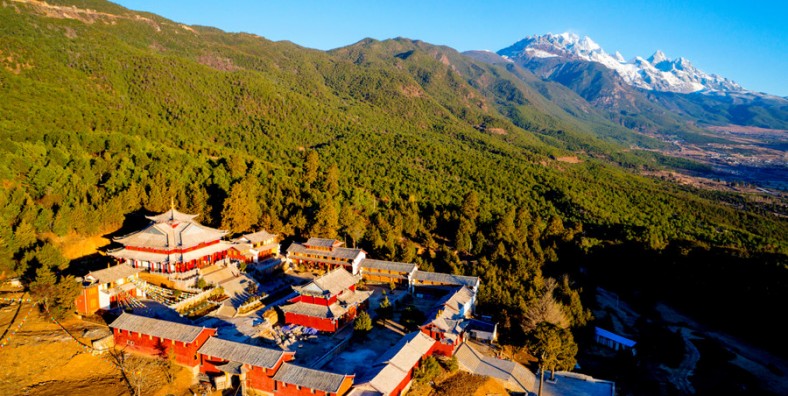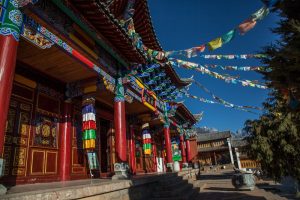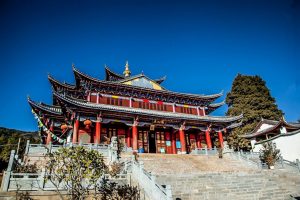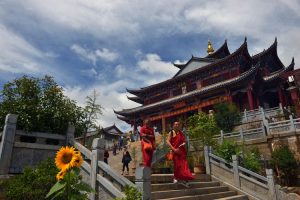 alt="Market Days in Menglian and Townships, Puer"
/>
alt="Market Days in Menglian and Townships, Puer"
/>
Fuguo Monastery, Lijiang

Chinese Nmae: 丽江福国寺
English Name: Fuguo Monastery, Lijian
Chinese Pinying: Fu Guo Si
Location: Located in Baisha Township, Yulong County, Lijiang City
Highlights: One of the 5 famous Lamaist Monasteries in Lijiang
Open Hour: 08:30-17:00
Ticket: 0 CNY
Fuguo Monastery overview
This monastery used to be the largest in the Lijiang Valley but was completely destroyed. It is now overseen by an 80 year old Monk whose favorite English expression is “Nice to Meet You”. It sits high up on a hill which defeated us on bicycles months ago but which a minivan was able to negotiate. The monk warmly welcomes people into the second floor of his house with tea and incense and visitors’ registers. It seems many people found their way to his home while biking up the hill in a rain storm. Li and Silas had their photos taken with this Lama and we all received blessings.
History of Fuguo Monastery
Fuguo Monastery, the name of the Ao Min Nan Zhuo lin, meaning ” the court for Relief.” Located in Baisha Township, Yulong County, Lijiang City, it was built in the thirty-ninth year of Wanli Period(1601) in the Ming Dynasty. It was originally the home of Mu’s Family. Mu’s officer invited the Han Dynasty Mahayana Buddhism monks to practice and become the Han Buddhism Zen Temple. The name of the temple is “Relieved Forest”, and the name of the temple is “Fuguo Temple”, which was named by Emperor Zhu Youxiao in Ming Dynasty, and it is the mother temple of the five major temples in Lijiang, Karmapa, Dasi Turenboqie, and Jiacharenboqie have hosted the Buddhanism Conference here.

What to see in Fuguo Monastery
The Wufeng Pavilion, which was built in 1601, has a history of 400 years. It was originally an important building in the “Relief Forest” of the villa of the Ming Dynasty. The old name of the Fayun Pavilion is named after the five flying eaves that look like five phoenixes from different angles. Some people say that “it is not because Wufenglou is a unique and fascinating building, nor is it a delicate sculpture and gorgeous painting in the building. It is the building of the Bai, Tibetan, Naxi and Han. The features are perfectly integrated, and the whole building looks harmonious and elegant, and the momentum is majestic.”
Fuguo Monastery was destroyed in 1864. In 1882, the temple was rebuilt. Some people think that the existing Fayun Pavilion seems to be reconstructed by imitation of the Ming Dynasty. The temple was destroyed during the Cultural Revolution. Only the gates of Wufenglou and Relieved Forest were preserved. In 1979, it moved to Heilongtan Park in Lijiang City. Wufenglou has the high value of art, science and history, and the people who visit the Black Dragon Pool will visit the Wufeng Building.
In 2007, the 17th Dongbao Zhongba Living Buddha, was responsible for the restoration of the Fuguo Monastery. After several years, overcoming many difficulties, the Fuguo Temple was born again in 2015. It was completed in 2015 and reconstructed the main building of the temple centered on the Wufeng Pavilion and the Relief Rorest, recreating the majestic and magnificent Monastery.

In the worship of Fuguo Temple, in addition to feeling the extraordinary momentum of the temple, and the brave heart of today’s people rebuilding the Buddha’s veins and renewing the Buddha’s life, the other is very touched which is that in recent years, dozens of children from Sichuan have been accepted. Poor children in Daocheng and surrounding areas of Lijiang are accepted there, and people set up classrooms, offer food and accommodation, teach culture, and teach Buddhist scriptures in the temples, so the sorrowful feelings of Buddhism can be reflected in the real society. At the same time, there are students from various colleges and universities who come to Fuguo Temple. The shortest time that they stayed there is three months and the long one is nearly five years.
Outside the mountain gate of Fuguo Temple, there is a tall and unique ginkgo tree. This rare ginkgo tree adds energies to the ancient temples. At this time, it is showing the most beautiful figure of the year, full of golden trees, while looking up just like that the nature has raised a big brush full of golden oil paint, to draw a picture of the most beautiful for the blue sky, which let people feel the fall, and make the spirit a shock. A gust of wind swayed, shaking a tree of gold, and laying a layer of “golden carpet” on the ground, such as the soldiers to the city, the city full of gold armor, and there is a prestige, magnificent and comfortable.
Attractions Near Puji Monastery
The Baisha Ancient Village is one of the oldest towns in Lijiang City. It got its name “Baisha” meaning “white sand” from the natural white sand in the area. It was the cradle-land of the Tusi Dynasty evolved from the Mu Clan. It was also the earliest settlement of the Naxi people. There are many ancient constructions built in the Ming Dynasty: the Dabaoji Palace, the Liuli Temple and the Wenchang Palace. The well-known Baisha Frescoes are situated in the Dabaoji Palace.
Lijiang Jade Dragon Snow Mountain Golf Course
Jade Dragon Snow Mountain Golf Club is one of the icons of China golf. This Kunming golf course is set in the bottom of a valley that faces the famous Jade Dragon Snow Mountain that is 5596 meters (18,360 ft.) high. You can enjoy mountain views from almost every place on this Kunming golf course. Jade Dragon Snow Mountain Golf Club is situated at 3100 meters (10,800 ft.) above see level, the second highest in the world and the highest in Asia.
Jade Water Village or Yushuizhai in Lijiang
Yushuizhai is under the foot of the Yulong Snow Mountain, facing the ancient city of Lijiang, which is only 15 kilometers from the city. The sacred water out of the Yushui Village brings up a generation after generation, giving them courage, wisdom and happiness.
Black Dragon Pool (also Heilongtan), or Jade Spring(Yuquan) Park is the main headwater of the Yushui River which goes through the Old Town. People believe that the gods of the Naxi people are living in the chestnut woods, beside the mouth of springs, behind the carved doors and below the bridges. The springs come from the god-protected mountains and gather in this place and finally form the dragon pool. Then water goes down a waterfall and becomes the Yuhe River, pouring life to the Old Town.
A trekking route leads to the amazing Dongba Valley. It is located at the foot of Jade Dragon Snow Mountain and 15 kilometers away from Lijiang Old Town. The Dongba Valley is home and livelihood of Naxi people. Traditional houses of Naxi and other peoples are open to visit.
Admission Fee:¥230
Opening Hours:6:00-18:00 (May 1st to Oct. 31st); 6:30-18:00 (Nov. 1st to Apr. 30)
Attraction Transportation:Because there is no public bus, tourists need to charter a taxi / car/ mini-van or carpool together from the downtown area. The distance is around 10 miles (15 kilometers). It takes around 40 minutes. The round-trip charter rate is around CNY 200.
Recommended Accommodation
1.Inter Continental Lijiang Ancient Town Resort(丽江和府洲际度假酒店)
Located in the southern of Lijiang Old Town, the InterContinental Lijiang Ancient Town Resort is the international five-star conference and resort which combines modern luxury, traditional Naxi architectural, and the local representative landscape. Hotel has 274 spacious rooms and suites, 4 restaurants and bars, Spa and Fitness center. It is a 10-minute walk from Sifangjie (Market Square), a 30-minute drive from Lijiang Airport.
2.Hotel Indigo Lijiang Ancient Town(丽江古城英迪格酒店)
Hotel Indigo Lijiang Ancient Town is located in Lijiang Ancient Town. It features a wellness center, an indoor pool and a fitness center. The luxurious rooms offer free wired internet. At Hotel Indigo Lijiang Ancient Town you will find a la carte restaurant and buffet restaurant. Breakfast can be served in the comforts of guests’ rooms.
3.Lijiang Wangfu Hotel(丽江王府饭店)
Lijiang Wangfu Hotel is located in the South Gate Square in Old Town. Featuring colorful traditional Chinese architecture and décor, it offers rooms with flat-screen TVs and free internet. Guest can enjoy Naxi bonfire party every Friday. The hotel provides car rental and concierge services. A tour desk can help with travel and sightseeing arrangements.
4.Manty House(漫庭美宿酒店)
Situated in Lijiang, this inn is within a 15-minute walk of Mu Family Mansion, Dayan and Wang Gu Lou. It features a restaurant, a bar/lounge and coffee/tea in a common area. WiFi in public areas is free. Other amenities include dry cleaning, a 24-hour front desk and tour/ticket assistance.
5.Lijiang International Hotel(丽江国际大酒店)
Lijiang International Hotel is located in Lijiang, 400 m from Wangu Pavilion and 600 m from Square Street Dayan Ancient Town. Guests can enjoy the on-site bar. Every room at this hotel is air conditioned and is fitted with a flat-screen TV with satellite channels. You will find a coffee machine in the room. For your comfort, you will find bathrobes and slippers.

Fuguo Temple Travel Tips
1. To Fuguo Temple, the best way to get around is to ride a bicycle. Lijiang to Baisha Ancient Town is 10 km away. Baisha Ancient Town to Fuguo Temple is 4.5 km of Panshan Highway. It is not steep, but the scenery is good. You can see Jade Dragon Snow Mountain along the way. Overlooking the ancient town of Baisha and the ancient city of Lijiang.
2, By car, you can take the No. 6 bus from Lijiang to Baisha Ancient Town, then charter to Fuguo Temple.
3, Self-driving, walk 10 kilometers along Shubai Road to Baisha Ancient Town, turn left into Wenhai Road, and walk up a 4.5-km winding mountain road to Fuguo Temple.
4, Fuguo Temple does not accept tickets, the temple has a lot of poor children, if you like, you can bring some stationery or sporting goods to them.
5. In addition to rebuilding the new Wufeng Pavilion and the Relief Forest, Fuguo Temple is also a perfect place to enjoy the Jade Dragon Snow Mountain. The tall ginkgo tree in front of the door is also a good place for photography.

 7 Days GolfingTour
7 Days GolfingTour
 8 Days Group Tour
8 Days Group Tour
 8 Days Yunnan Tour
8 Days Yunnan Tour
 7 Days Shangri La Hiking
7 Days Shangri La Hiking
 11 Days Yunnan Tour
11 Days Yunnan Tour
 6 Days Yuanyang Terraces
6 Days Yuanyang Terraces
 11 Days Yunnan Tour
11 Days Yunnan Tour
 8 Days South Yunnan
8 Days South Yunnan
 7 Days Tea Tour
7 Days Tea Tour
 8 Days Muslim Tour
8 Days Muslim Tour
 12 Days Self-Driving
12 Days Self-Driving
 4 Days Haba Climbing
4 Days Haba Climbing
 Tiger Leaping Gorge
Tiger Leaping Gorge
 Stone Forest
Stone Forest
 Yunnan-Tibet
Yunnan-Tibet
 Hani Rice Terraces
Hani Rice Terraces
 Kunming
Kunming
 Lijiang
Lijiang
 Shangri-la
Shangri-la
 Dali
Dali
 XishuangBanna
XishuangBanna
 Honghe
Honghe
 Kunming
Kunming
 Lijiang
Lijiang
 Shangri-la
Shangri-la
 Yuanyang Rice Terraces
Yuanyang Rice Terraces
 Nujiang
Nujiang
 XishuangBanna
XishuangBanna
 Spring City Golf
Spring City Golf
 Snow Mountain Golf
Snow Mountain Golf
 Stone Mountain Golf
Stone Mountain Golf













 What Our Customers Say?
What Our Customers Say?
